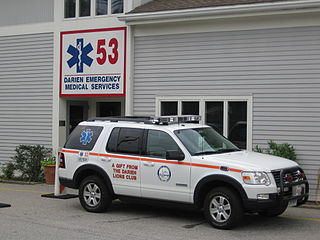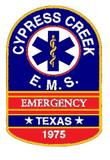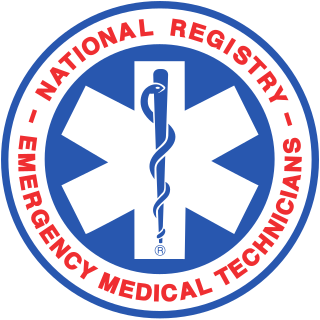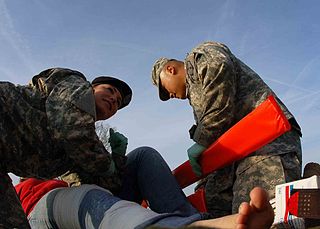
Emergency medical services (EMS), also known as ambulance services or paramedic services, are emergency services that provide urgent pre-hospital treatment and stabilisation for serious illness and injuries and transport to definitive care. They may also be known as a first aid squad, FAST squad, emergency squad, ambulance squad, ambulance corps, life squad or by other initialisms such as EMAS or EMARS.

An emergency medical technician is a medical professional that provides emergency medical services. EMTs are most commonly found serving on ambulances.

A paramedic is a healthcare professional who responds to emergency calls for medical help outside of a hospital. Paramedics mainly work as part of the emergency medical services (EMS), most often in ambulances. The scope of practice of a paramedic varies among countries, but generally includes autonomous decision making around the emergency care of patients.
In the United States, an interstate compact is a pact or agreement between two or more states, or between states and any foreign government. The Compact Clause of the United States Constitution provides that "No State shall, without the Consent of Congress,... enter into any Agreement or Compact with another State, or with a foreign Power,..."

A certified first responder is a person who has completed a course and received certification in providing pre-hospital care for medical emergencies. Certified individuals should have received much more instruction than someone who is trained in basic first aid and cardiopulmonary resuscitation (CPR) but they are not necessarily a substitute for more advanced emergency medical care rendered by emergency medical technicians and paramedics. First responders typically provide advanced first aid level care, CPR, and automated external defibrillator (AED) usage. The term "certified first responder" is not to be confused with "first responder", which is a generic term referring to the first medically trained responder to arrive on scene and medically trained telecommunication operators who provide pre-arrival medical instructions as trained Emergency Medical Dispatchers (EMD). Many police officers and firefighters are required to receive training as certified first responders. Advanced medical care is typically provided by EMS, although some police officers and firefighters also train to become emergency medical technicians or paramedics.

The California Emergency Medical Services Authority is an agency of California State government. The California EMS Authority is one of the thirteen departments within the California Health and Human Services Agency. The director is required to be a physician with substantial experience in emergency medicine. Elizabeth Basnett is the current Acting Director.

In the United States, the paramedic is a allied health professional whose primary focus is to provide advanced emergency medical care for patients who access Emergency Medical Services (EMS). This individual possesses the complex knowledge and skills necessary to provide patient care and transportation. Paramedics function as part of a comprehensive EMS response under physician medical direction. Paramedics often serve in a prehospital role, responding to Public safety answering point (9-1-1) calls in an ambulance. The paramedic serves as the initial entry point into the health care system. A standard requirement for state licensure involves successful completion of a nationally accredited Paramedic program at the certificate or associate degree level.

Louisville Metro Emergency Medical Services is the primary provider of pre-hospital life support and emergency care within Louisville-Jefferson County, Kentucky. LMEMS is a governmental department that averages 90,000 calls for service, both emergency and non-emergency, each year.

In the United States, emergency medical services (EMS) provide out-of-hospital acute medical care and/or transport to definitive care for those in need. They are regulated at the most basic level by the National Highway Traffic Safety Administration, which sets the minimum standards that all states' EMS providers must meet, and regulated more strictly by individual state governments, which often require higher standards from the services they oversee.
In the US, paramedicine is the physician-directed practice of medicine, often viewed as the intersection of health care, public health, and public safety. While discussed for many years, the concept of paramedicine was first formally described in the EMS Agenda for the Future. Paramedicine represents an expansion of the traditional notion of emergency medical services as simply an emergency response system. Paramedicine is the totality of the roles and responsibilities of individuals trained and credentialed as EMS practitioners. These practitioners have been referred to as various levels of Emergency Medical Technician (EMTs). In the United States paramedics represent the highest practitioner level in this domain. Additional practitioner levels in this domain within the U.S. include Emergency Medical Responders (EMRs), Emergency Medical Technicians (EMTs) and Advanced Emergency Medical Technicians (AEMTs).

Cypress Creek Emergency Medical ServicesAssociation, also known as Cypress Creek EMS (CCEMS) was a private, non-profit emergency medical service provider for Harris County ESD 11 in North Harris County, within greater Houston, Texas. In 2021, CCEMS declared bankruptcy and operations ceased in mid 2022. In late 2022, the remaining assets, branding, and trademarks were bought by Viking Enterprises, DBA City Ambulance Service. All ambulances in use by CCEMS are Mobile Intensive Care Units (MICU), with at least one Paramedic, making all ambulances ALS units. Cypress Creek EMS provided 911 service in North Harris County, provided bicycle medic teams for special events, provided tactical EMS support for federal, state, and local law enforcement, and operated an accredited educational institution.

The National Registry of Emergency Medical Technicians is a US certification agency covering prehospital medical providers.
An advanced emergency medical technician is a provider of emergency medical services in the United States. A transition to this level of training from the emergency medical technician-intermediate, which have somewhat less training, began in 2013 and has been implemented by most states. AEMTs are not intended to deliver definitive medical care in most cases, but rather to augment prehospital critical care and provide rapid on-scene treatment. AEMTs are usually employed in ambulance services, working in conjunction with EMTs and paramedics; however they are also commonly found in fire departments and law enforcement agencies as non-transporting first responders. Ambulances operating at the AEMT level of care are commonplace in rural areas, and occasionally found in larger cities as part of a tiered-response system, but are overall much less common than EMT- and paramedic-level ambulances. The AEMT provides a low-cost, high-benefit option to provide advanced-level care when the paramedic level of care is not feasible. The AEMT is authorized to provide limited advanced life support, which is beyond the scope of an EMT.
Emergency Medical Technician is the entry level of Emergency Medical Technician in the United States.
In the United States, the licensing of prehospital emergency medical providers and oversight of emergency medical services are governed at the state level. Each state is free to add or subtract levels as each state sees fit. Therefore, due to differing needs and system development paths, the levels, education requirements, and scope of practice of prehospital providers varies from state to state. Even though primary management and regulation of prehospital providers is at the state level, the federal government does have a model scope of practice including minimum skills for EMRs, EMTs, Advanced EMTs and Paramedics set through the National Highway Traffic Safety Administration (NHTSA).

Emergency medical responders are people who are specially trained to provide out-of-hospital care in medical emergencies. There are many different types of emergency medical responders, each with different levels of training, ranging from first aid and basic life support. Emergency medical responders have a very limited scope of practice and have the least amount of comprehensive education, clinical experience or clinical skills of emergency medical services (EMS) personnel. The EMR program is not intended to replace the roles of emergency medical technicians or paramedics and their wide range of specialties. Emergency medical responders typically assist in rural regions providing basic life support where pre-hospital health professionals are not available due to limited resources or infrastructure.

State Medical Rescue in Poland is a system of free public emergency healthcare established by Ustawa o Państwowym Ratownictwie Medycznym, including ambulance service and Emergency Departments (EDs). While in Polish public hospitals and clinics NFZ common public insurance is required, PRM medical services in ambulances and EDs are completely free for everyone. Since 2018 emergency ambulances that operates in PRM, that is Polish 112 and 999 emergency numbers, are operated by public entities only.
Emergency medical services in Iceland include the provision of ambulance service. They provide all emergency ambulance service for a population of in excess of 320,000 people in one of the most sparsely settled countries in Europe. The system is government-funded for the first 85 percent of cost, with 15 percent being charged to the individual as a deterrent fee. All services in Iceland are provided by the Icelandic Red Cross, with individual ambulances often co-located with local fire brigades.
Emergency medical services in Sri Lanka is being established using a public/private system aimed at the provision of emergency ambulance service, including emergency care and transportation to hospitals. The Pre-Hospital Care Committee is part of the Trauma Secretariat of the Sri Lanka Ministry of Healthcare and Nutrition and was established following the 2004 tsunami. The goal of the Pre-Hospital Care Sub-Committee is “During this generation and continuing for future generations, everyone in Sri Lanka will have access to trained pre-hospital medical personnel, ambulances are available to transport the sick and injured safely to hospitals, complications from harmful or inadequate pre-hospital care is eliminated so physician and nursing personnel at hospitals are delivered patients they are able to professionally treat and rehabilitate back to society as contributing citizens.” Pre-Hospital care is an essential, core component of trauma system.











